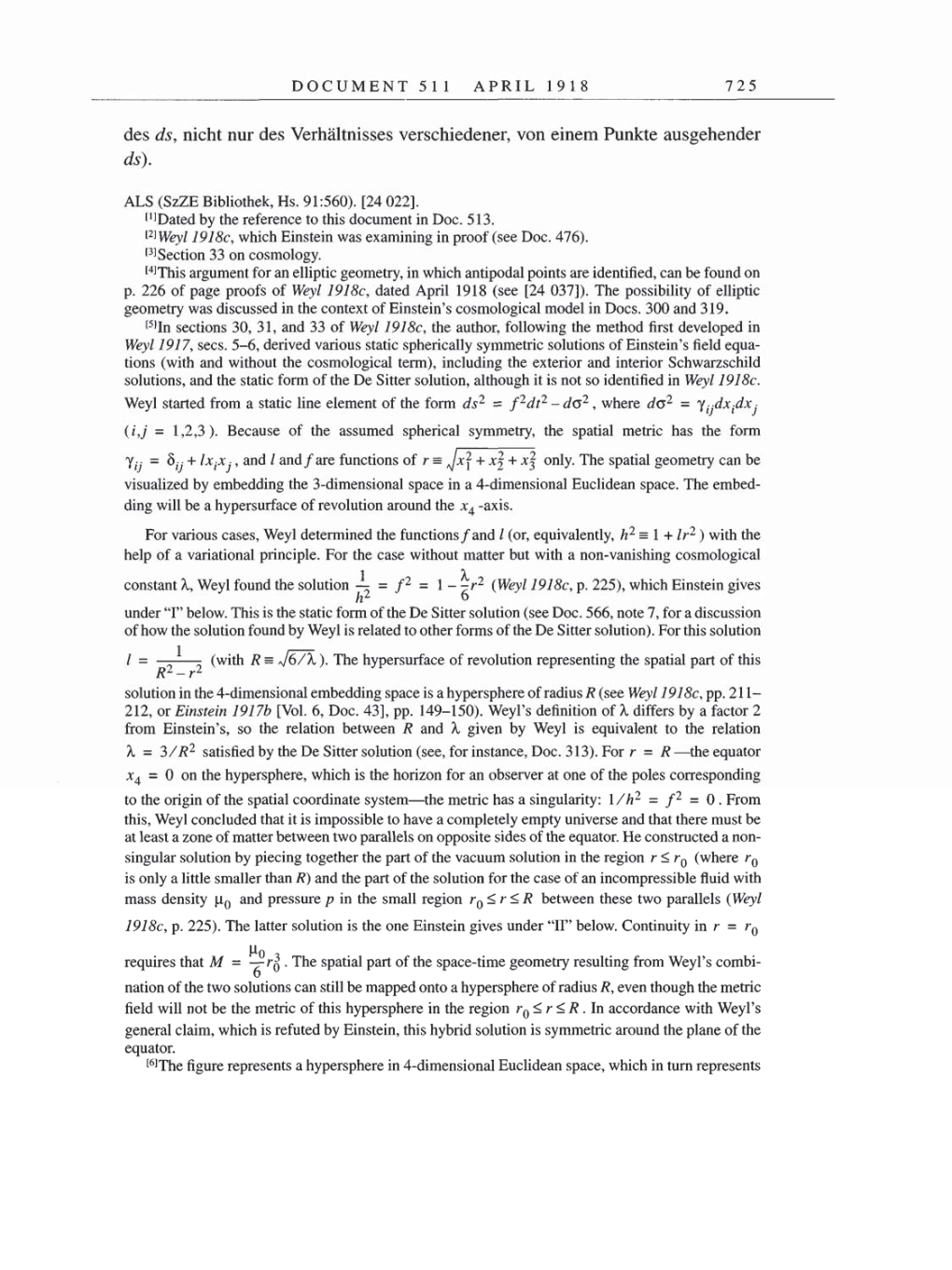DOCUMENT 511 APRIL 1918 725
des
ds,
nicht
nur
des Verhältnisses
verschiedener,
von
einem Punkte
ausgehender
ds).
ALS
(SzZE Bibliothek,
Hs.
91:560). [24 022].
[1]Dated
by
the reference
to
this
document
in Doc. 513.
[2]Weyl
1918c,
which Einstein
was examining
in
proof (see
Doc.
476).
[3]Section
33
on cosmology.
[4]This
argument
for
an elliptic geometry,
in which
antipodal points are
identified,
can
be found
on
p.
226
of
page proofs
of
Weyl
1918c,
dated
April
1918
(see
[24 037]).
The
possibility
of
elliptic
geometry was
discussed in the
context
of
Einstein’s
cosmological
model in Docs. 300 and 319.
[5]In
sections
30, 31,
and 33
of
Weyl
1918c,
the
author,
following
the method first
developed
in
Weyl
1917,
secs.
5-6, derived various static
spherically symmetric
solutions
of
Einstein’s field
equa-
tions
(with
and without the
cosmological
term),
including
the exterior and interior Schwarzschild
solutions,
and the static form
of
the De Sitter
solution,
although
it is not
so
identified in
Weyl
1918c.
Weyl
started from
a
static line element
of
the form ds2
=
f2dt2-da2,
where
da2
=
yijdxidxj
(i,j
=
1,2,3). Because
of
the assumed
spherical symmetry,
the
spatial
metric
has the
form
Yij
=
dij
+
lxixj,
and
l
and
ƒ
are
functions
of
r
= Jx21+x22+x23
only.
The
spatial geometry
can
be
visualized
by embedding
the 3-dimensional
space
in
a
4-dimensional Euclidean
space.
The embed-
ding
will be
a hypersurface
of
revolution around the
x4
-axis.
For various
cases, Weyl
determined the functions ƒ and
l (or, equivalently, h2
= 1
+
lr2)
with the
help
of
a
variational
principle.
For the
case
without matter but with
a non-vanishing cosmological
constant y,
Weyl
found the solution
1/h2
=
f2
=
1-y/6r2
(Weyl
1918c,
p.
225),
which Einstein
gives
under "I" below. This is the static form
of
the
De Sitter solution
(see
Doc.
566, note 7,
for
a
discussion
of
how the solution found
by Weyl
is related
to
other forms
of
the De Sitter
solution).
For this solution
l
=
1/R2-r2
(with
R
=
J6/y).
The
hypersurface
of
revolution
representing
the
spatial part
of this
solution in the 4-dimensional
embedding space
is
a hypersphere
of
radius
R (see
Weyl
1918c,
pp.
211-
212, or
Einstein 1917b
[Vol.
6,
Doc.
43], pp.
149-150).
Weyl’s
definition
of
X
differs
by a
factor 2
from
Einstein’s, so
the relation between R and
X given by Weyl
is
equivalent
to the relation
y
=
3/R2
satisfied
by
the De Sitter solution
(see,
for
instance,
Doc.
313).
For
r
=
R
-the
equator
x4 =
0
on
the
hypersphere,
which is the horizon
for
an
observer at
one
of
the
poles corresponding
to
the
origin
of
the
spatial
coordinate
system-the
metric has
a
singularity:
1/h2
=
ƒ2
=
0.
From
this,
Weyl
concluded that it is
impossible
to
have
a completely empty
universe and that there must be
at
least
a zone
of
matter
between
two
parallels on opposite
sides
of
the
equator.
He
constructed
a non-
singular
solution
by piecing
together
the
part
of
the
vacuum
solution in the
region rr0
(where
r0
is
only a
little smaller than
R)
and the
part
of
the solution for the
case
of
an incompressible
fluid with
mass density
u0
and
pressure
p
in the small
region
r0rR
between these
two
parallels (Weyl
1918c,
p. 225).
The latter solution is the
one
Einstein
gives
under
"II"
below.
Continuity
in
r
=
r0
requires
that M
=
u0/6r30.
The
spatial
part
of
the
space-time
geometry
resulting
from
Weyl’s
combi-
nation
of
the
two
solutions
can
still be
mapped
onto
a hypersphere
of
radius
R,
even though
the metric
field will
not
be the metric
of
this
hypersphere
in the
region
r0rR. In accordance with
Weyl’s
general claim,
which is refuted
by
Einstein,
this
hybrid
solution is
symmetric
around the
plane
of
the
equator.
[6]The figure represents a hypersphere
in
4-dimensional
Euclidean
space,
which in
turn
represents
